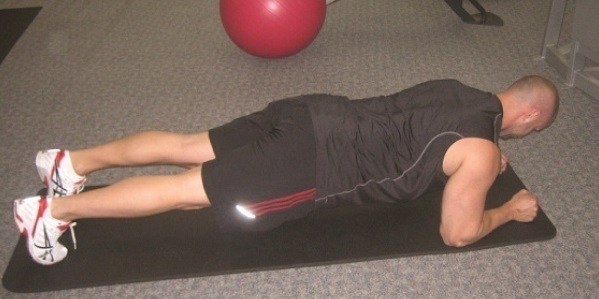The plank is a versatile exercise that personal trainers can adapt for various skill levels and abilities.
Exercise Name & Target Muscle Group
Trunk stabilization, commonly referred to as “the plank”, is an exercise designed to target the abdominals. However, because this exercise requires stabilizing efforts from other muscle groups, the plank can improve strength in the shoulders and hips. Additionally, balance benefits can be achieved by performing variations of this exercise (such as the side plank). In contrast to the traditional crunch or sit-up, which only targets the abdominals and uses forceful trunk flexion – a movement that will be problematic for any client who has osteoporosis or intervertebral disc concerns.
Why Plank is Performed
The primary purpose is to strengthen the abdominals and back using an isometric contraction. Note – if you are working with a client who is suffers from documented high blood pressure, an isometric exercise may be contraindicated as those types of exercises are known to increase blood pressure.
The plank is a popular exercise and, if executed properly and integrated effectively into a client’s program, can help develop an aspect of core strength necessary to stabilize the spine. Simply stated, developing strength in the abdominals and core will assist clients in their ability to perform other more taxing and complicated exercises with greater efficiency and proper form.

How To Plank Properly
Proper Execution
For a standard elbow front plank (like the one pictured), execute it properly by:
- Start in a kneeling position on the floor. Place feet shoulder-width apart. Keep feet, ankle, knees, and hips in a vertical plane, i.e. your legs should be parallel.
- Place the palms of the hands flat on the floor shoulder-width apart, allowing a straight line to form from knees to shoulders. Forearms should be parallel, elbows should be pointing directly back – not out to the side. Head and neck should remain neutral throughout.
- Drop the elbows to the floor (one side at a time) and place them under the shoulders (exactly where hands started). Forearms should still be parallel. This is modified low plank position and where beginners should start! To advance to conventional plank, incorporate step four.
- Raise knees off of the ground; hips and shoulders should remain parallel to the floor while the legs are straight.
- Tighten the core by drawing the belly button to the spine, forcing breath into the upper chest, and hold the position.
- Maintain the position as long as possible. When form starts to fail, the repetition is over
- At the end of the repetition, return to a resting position.
If the client experiences stress in the low back and arms versus the abdominals and legs, check the form and make the necessary changes if strength is available and they respond to cueing.
Plank Variations
The plank can be performed in a variety of ways to increase the intensity and challenge of the traditional form. Some versions of the plank include:
- Side plank (with or without hip abduction)
- Mountain climbers
- Plank jacks
- Plank variations using a stability ball or TRX system
- Single-leg plank (raising one leg up at a time).
- Up-down planks
- Rocking plank
- Two-point plank
- Alternating front-to-side plank
- Reverse plank (add a leg lift for another dimension and challenge)
- Plank with dumbbell row (Renegade Row)
- Plank with arm abduction
Common Plank Mistakes
- Hips sag too low
- Hips and buttocks elevated too high
- Lack of a neutral spine (neck is flexed or extended rather than neutral)
- Elbows point outward
- Shoulders do not remain retracted
- Ineffective activation of the transverse abdominus and glute muscles
Dr. Erin Nitschke, NFPT-CPT, NSCA-CPT, ACE Health Coach, Fitness Nutrition Specialist, Therapeutic Exercise Specialist, and Pn1 is a health and human performance college professor, fitness blogger, mother, and passionate fitness professional. She has over 15 years of experience in the fitness industry and college instruction. Erin believes in the power of a holistic approach to healthy living. She loves encouraging her clients and students to develop body harmony by teaching focused skill development and lifestyle balance. Erin is also the Director of Educational Partnerships & Programs for the NFPT. Erin is an editorial author for ACE, IDEA, The Sheridan Press, and the Casper Star Tribune. Visit her personal blog at belivestaywell.com

